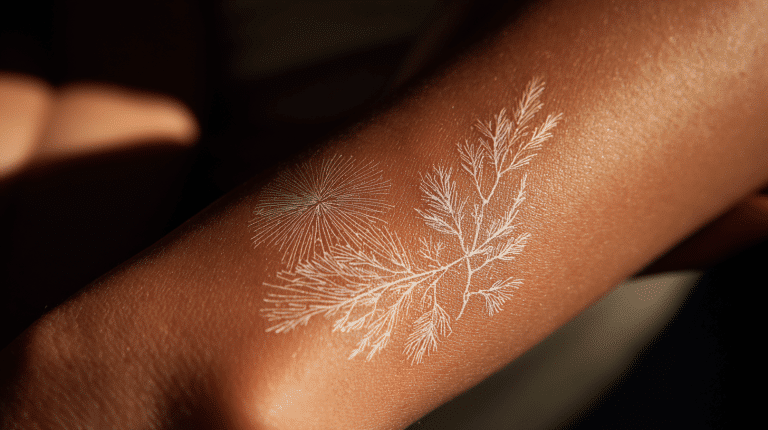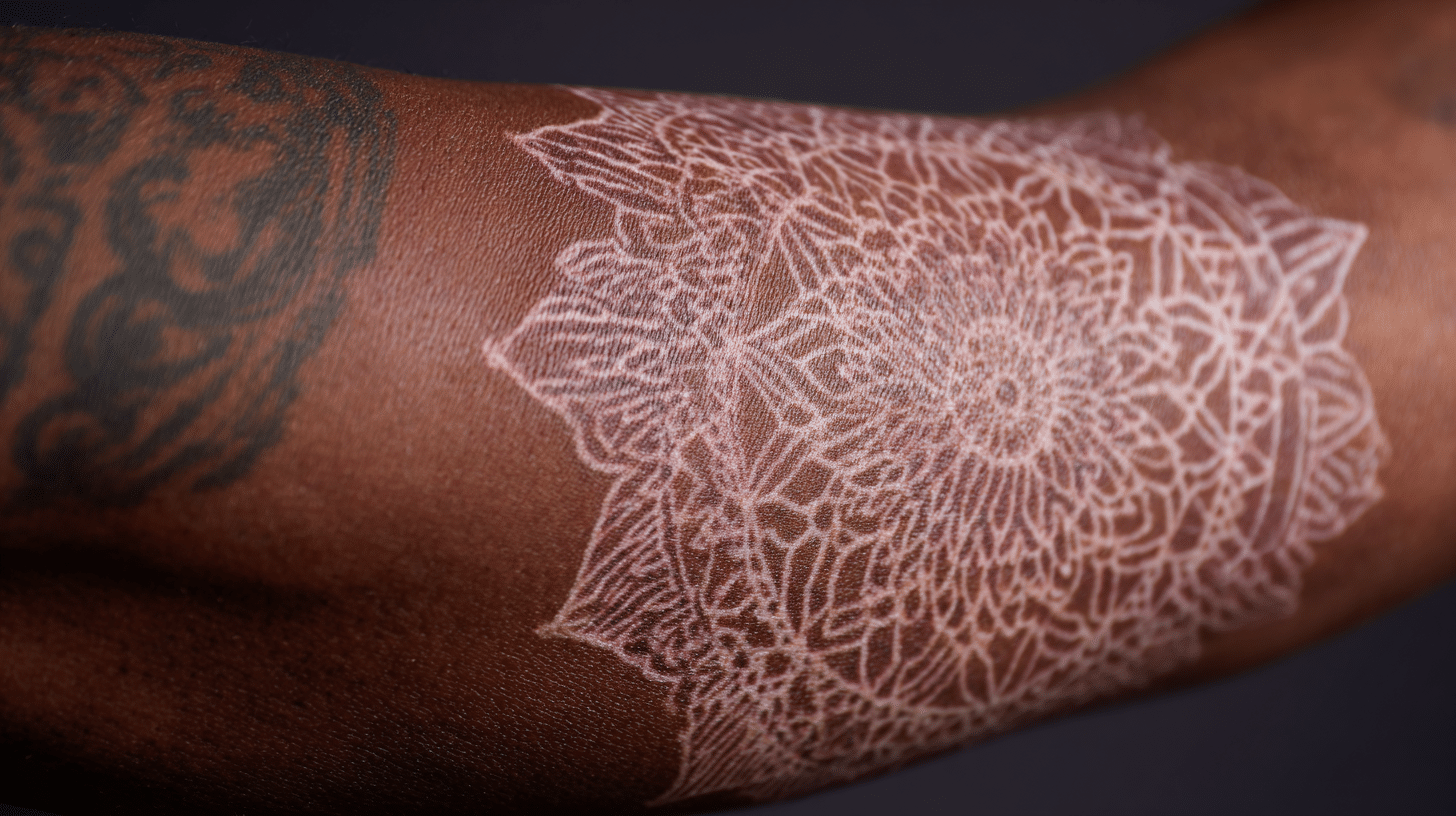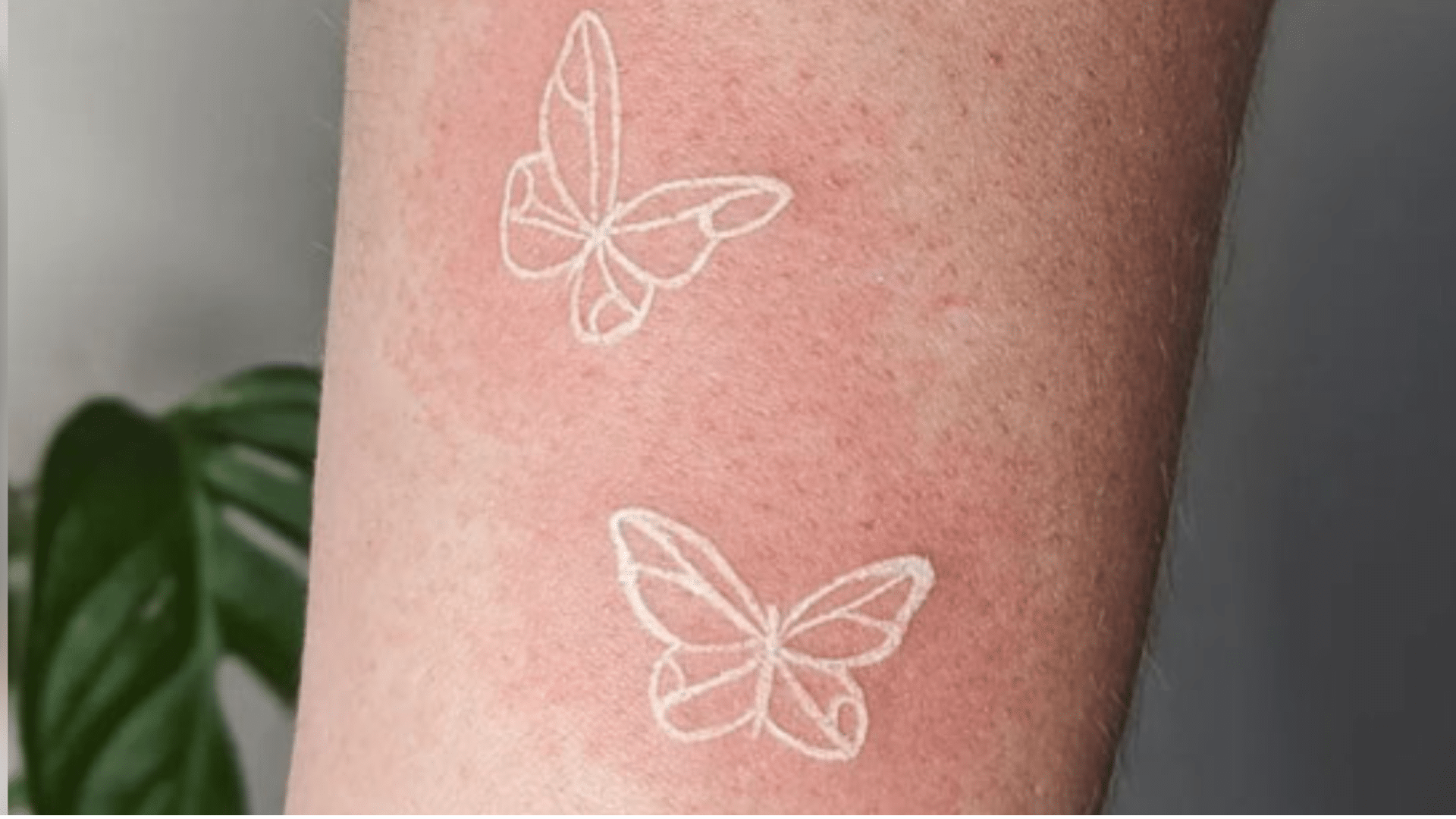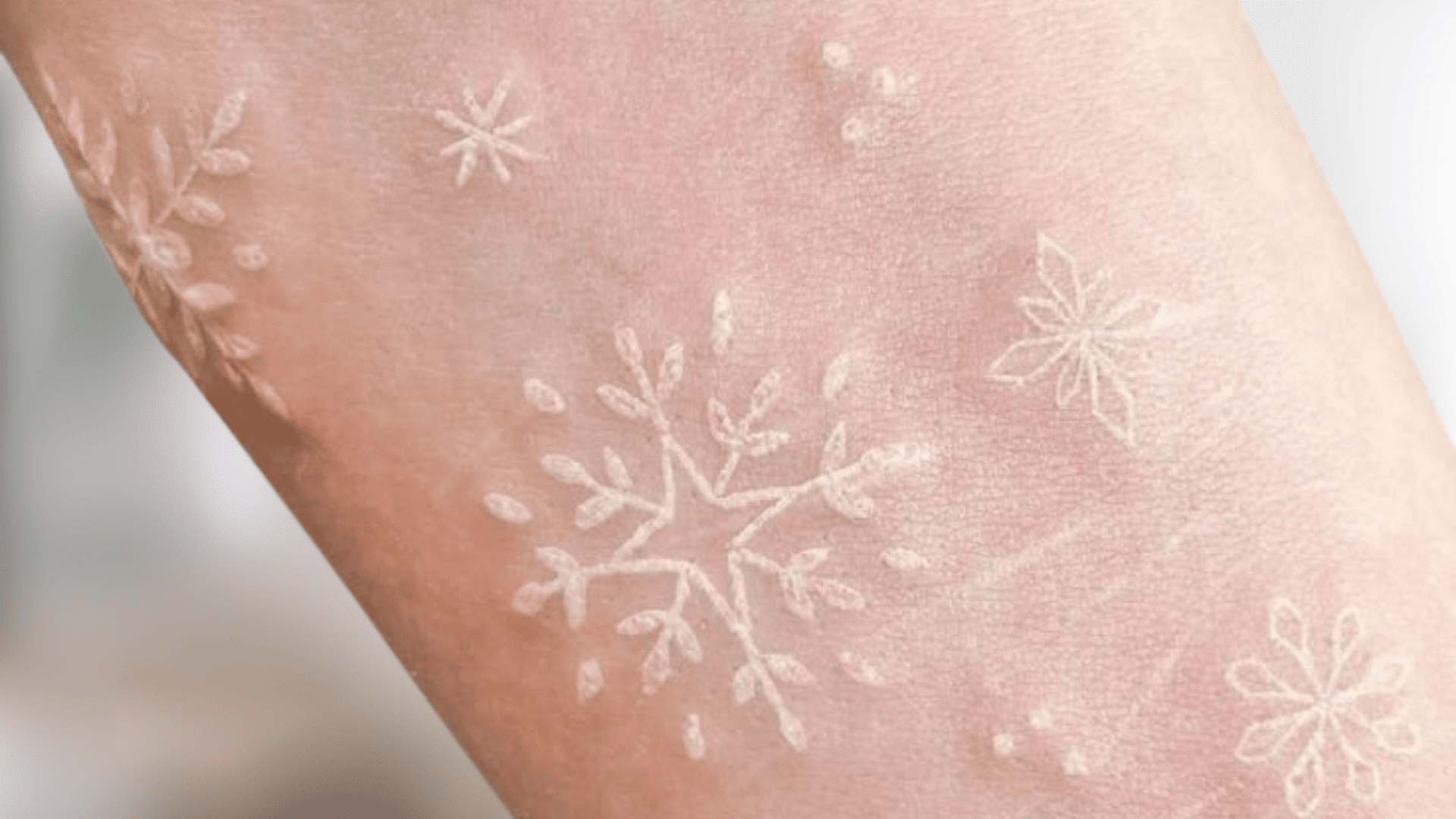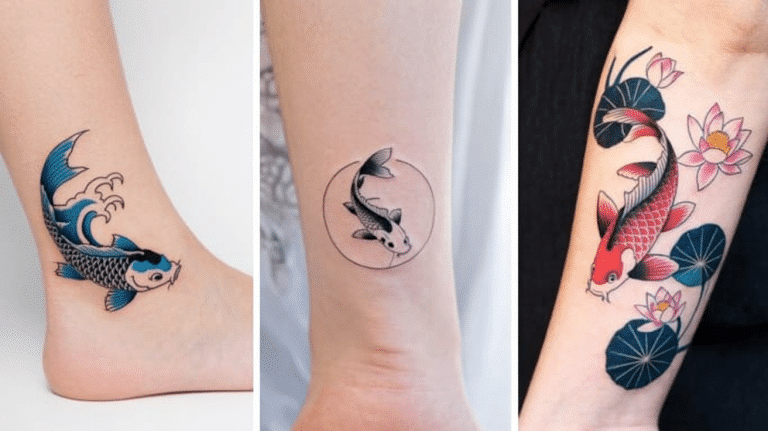White ink tattoos are creating quite a buzz in the tattoo world. These subtle designs offer something completely different from traditional black ink tattoos.
They have been gaining popularity, especially among people who want body art that’s more mysterious and unique.
Unlike bold black tattoos that make a statement from across the room, white tattoos whisper rather than shout.
But before you rush to get one, there’s a lot more to white tattoos than meets the eye. If you’re curious about white ink tattoos, you’ve come to the right place.
This guide covers everything from how they look and heal to what they cost and what tattoo artists want you to know before you commit.
The Appeal of White Ink Tattoos
White tattoos create an almost graceful look on your skin, like subtle lace patterns or subtle scars that tell a story.
They’re particularly glowing on darker skin tones, where the contrast creates a beautiful, raised appearance that looks almost like decorative scarring.
For many people, the discreet nature is precisely what they’re looking for. Maybe you work in a conservative office, or perhaps you want a tattoo that feels more personal. White ink gives you that option.
These tattoos are like secret art that only shows up in certain lighting or when someone looks closely.
Key Characteristics of White Ink Tattoos
White ink tattoos offer a subtle, translucent appearance that creates a unique alternative to traditional black ink designs.
These tattoos heal with a slightly raised texture and change visibility depending on lighting conditions.
- More discreet and subtle than conventional tattoos
- Works exceptionally well as a highlight in colorful designs
- Create a distinctive textured feel on the skin after healing
The Pros and Cons of White Ink Tattoos
Like any tattoo choice, white ink comes with its own set of advantages and challenges. Let’s break down what you can expect.
| The Good Stuff | The Challenges |
|---|---|
| Unique Look: White ink creates a subtle, magical look that stands out. | Fading: Over time, white ink tattoos can fade to yellow, gray, or even pink. |
| Ideal for Small Designs: Great for fine lines, minimalist symbols, and fine patterns. | Uneven Healing: White ink tattoos can heal unevenly, leaving patchy areas. |
| Beautiful on Dark Skin Tones: White ink creates a striking contrast and can appear luminous on darker skin. | Touch-Ups Are Tricky: White ink touch-ups may not blend well with the original tattoo, creating visible differences. |
| Perfect for Dainty Artwork: Works well for tattoos like constellation patterns, florals, and quotes. | Color and Texture Variations: New ink might heal differently than the original, causing color or texture differences. |
| Subtle and Graceful: Great for multiple small tattoos that don’t overwhelm the look. | Shorter Longevity: White ink doesn’t last as long as black ink, requiring more maintenance. |
How Long Do White Tattoos Last?
This is probably the most important question before getting a white tattoo. They don’t last as long as black tattoos, and longevity depends on several factors.
White ink fades faster than darker inks because it reflects light rather than absorbing it. This makes it more susceptible to breaking down from sun exposure and natural skin cell turnover.
Your skin tone plays a huge role in how your white tattoo ages. On lighter skin, white tattoos might fade to barely visible pale yellow or disappear almost entirely.
On darker skin tones, white ink tends to stay more visible longer but might shift from bright white to off-white or grayish colors.
Generally, expect a white tattoo to look its best for about 2-3 years. After that, you’ll likely notice fading or color changes.
Tips to Make Your White Tattoo Last Longer
Protecting your white ink tattoo from UV rays is essential, as sun exposure is the biggest threat to white ink longevity.
Maintaining healthy, well-moisturized skin helps preserve the ink and appearance over time.
- Always use sunscreen on your tattoo, even on cloudy days
- Apply fragrance-free moisturizer daily to keep skin hydrated
- Avoid harsh chemicals and excessive scrubbing when cleaning the area
Healing White Ink Tattoos: The Importance of Patience
White tattoos require a different healing mindset. During healing, your tattoo might look red, pink, or barely visible, but this is entirely normal.
White ink needs time to settle and find its final appearance.
While surface healing takes 2-4 weeks, like other tattoos, white tattoos can take up to 6 months to show their authentic final look. Many people panic during the first few weeks, but patience is key.
Aftercare is Critical: Follow your artist’s instructions exactly. Keep it clean but not too dry, use recommended ointment sparingly, and resist picking or scratching more than with regular tattoos.
Are White Ink Tattoos More Expensive?
White tattoos often cost more than traditional black ink tattoos for good reasons.
White ink is more challenging to work with and requires more skill and experience to apply correctly.
Many artists charge more for the extra time and expertise needed. White ink doesn’t penetrate the skin as deeply as black ink, so artists must work more carefully and often revisit areas multiple times.
White tattoos often take longer to complete because the artist needs to be more precise and may need to build up the white ink in layers. More time means higher costs.
Expect to pay anywhere from 20-50% more for a white ink tattoo compared to the same design in black ink.
Do White Tattoos Hurt More?
The pain level of white tattoos is pretty similar to regular tattoos, but some factors might make them feel different.
Some people report white tattoos hurt slightly more because the artist might need to go over the same area multiple times to get the ink to show up correctly.
This repeated work can make the skin more sensitive as the session continues.
However, pain is incredibly individual. Your pain tolerance, tattoo location, stress level, and general health affect how much a tattoo hurts more than the ink color.
Managing Pain
Get plenty of sleep the night before and eat a good meal beforehand. Your body handles pain better when well-rested and nourished.
Stay hydrated, but don’t overdo it right before your appointment.
Bring headphones for distraction during longer sessions. Music or podcasts help many people focus on something other than the tattoo process.
Talk to your artist about breaks if needed. Most artists are happy to give you time to reset if you’re struggling.
What Tattoo Artists Wish You Knew About White Ink Tattoos
Professional tattoo artists have seen countless white ink requests over the years, and they’ve learned what works and what doesn’t.
Their experience with white tattoos gives them valuable insights that can save you from disappointment and help you get the best possible results.
Here’s what they want every client to understand before committing to white ink.
1. Realistic Expectations Are Everything
Artists want clients to understand that white tattoos behave differently from any other type of tattoo. They’re not just regular tattoos in a different color – they’re a completely different category of body art with their own rules.
Many artists wish clients understood that white tattoos are more temporary art.
They’re beautiful, but they’re not as permanent as a black tattoo might be. Think of them as 2-5 year commitments rather than lifetime ones.
2. Design Matters
White ink works best with specific designs. Fine line work often looks incredible in white, while large, solid areas can heal unevenly and look patchy.
Simple designs often work better than complex ones. The subtle nature of white ink means intricate details might not show up clearly, especially as the tattoo ages.
3. Choose Your Artist Carefully
Not every talented tattoo artist is experienced with white ink. Look for artists with portfolios of healed white tattoos, not just fresh ones.
Ask to see photos of white tattoos they’ve done that are at least a year old. This gives you a realistic idea of how their white work ages.
4. Common Myths Artists Want to Bust
- White tattoos are invisible until healed. Fresh white tattoos are usually quite visible.
- White tattoos always turn yellow: Color changes vary – some fade to gray, some stay white, some become barely visible.
- You can’t touch up white tattoos: Touch-ups are possible but tricky and don’t always match perfectly.
Making the Right Choice
White tattoos offer a unique and subtle form of body art that requires careful consideration and realistic expectations.
While they create beautiful, ethereal effects and work particularly well on darker skin tones, they also come with challenges like faster fading, uneven healing, and higher maintenance requirements.
Success with white ink depends on choosing an experienced artist, understanding the healing process, and committing to proper aftercare, including sun protection.
With proper planning and realistic expectations, a white tattoo can be a stunning addition to your body art collection.
Share this guide with friends considering white tattoos and let us know your thoughts in the comments below!

